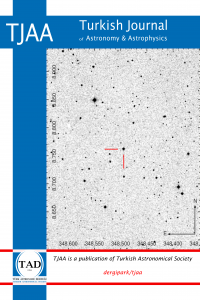Türkiye'deki Astronomi Çalışmalarına Genel Bakış ve Kurumların Bilimsel Performans Değerlendirmesinde Yeni Bir Yaklaşım
outreach, education, administration,
___
- Abramo, G., D'Angelo, C. A., & Viel, F. (2013) `The suitability of \em h and \em g indexes for measuring the research performance of institutions', \em Scientometrics, 97, 555.
- Batista, P. D., Campiteli, M. G, Kinouchi, O., & Martinez, A. S. (2006) `Is it possible to compare researchers with different scientific interests?', \em Scientometrics, 68, 179.
- Bilir, S., Göğüş, E., Önal, Ö., Öztürkmen, N. D., & Yontan, T. (2013) `Research performance of Turkish astronomers in the period of 1980-2010', \em Scientometrics, 97, 477.
- Boell, S. K., & Wilson, C. S. (2010) `Journal impact factors for evaluating scientific performance: use of \em h-like indicators', \em Scientometrics, 82, 613.
- Egghe, L. (2006) `Theory and practise of the \em g-index., \em Scientometrics' 69, 131.
- Franceschini, F., & Maisano, D. (2010) `Analysis of the Hirsch index's operational properties', \em European Journal of Operational Research, 203, 494.
- Franceschini, F., Maisano, D., & Mastrogiacomo, L. (2013) `Evaluating research institutions: the potential of the \em success-index', \em Scientometrics, 96, 85.
- Hagen, N. T. (2008) `Harmonic allocation of authorship credit: Source-level correction of bibliometric bias assures accurate publication and citation analysis', \em PLoS ONE, 3(12), e4021.
- Hirsch, J. E. (2005) `An index to quantify an individual's scientific research output', \em Proceedings of the National Academy of Sciences of the United States of America, 102, 16569.
- Jin, B., Liang L., Rousseau R., & Egghe, L. (2007) `The \em R- and \em AR-indices: Complementing the \em h-index', \em Chinese Science Bulletin, 52, 855.
- Levitt, J. M., & Thelwall, M. (2011) `A combined bibliometric indicator to predict article impact', \em Information Processing & Management, 47, 300.
- Liu, X. Z., & Fang, H. (2012) `Fairly sharing the credit of multi-authored papers and its application in the modification of \em h-index and \em g-index', \em Scientometrics, 91, 37.
- Vieira, E. S., & Gomes, J. A. N. F. (2010) `A research impact indicator for institutions', \em Journal of Informetrics, 4, 581.
- Yayın Aralığı: Yılda 2 Sayı
- Başlangıç: 2020
- Yayıncı: Türk Astronomi Derneği
Çağlar PÜSKÜLLÜ, Faruk SOYDUGAN, Ahmet ERDEM, Edwin BUDDING
Hasan H. ESENOĞLU, Irek HAMİTOĞLU, Kadir ULUÇ, Oğuzhan OKUYAN, Murat KOÇAK, Sıla ERYILMAZ KILIÇ, Murat PARMAKSIZOĞLU, Orhan ERECE, Süleyman KAYNAR, Tuncay ÖZIŞIK, Halil KIRBIYIK
F. Başak YILDIRAN, Nazım AKSAKER, Mohammad Shameoni NİAEİ, Yavuz GÜNEY, Erdem ERDİ, Cahit YEŞİLYAPRAK
Nazım AKSAKER, Sinan Kaan YERLİ, Mehmet Akif ERDOĞAN, Erdem ERDİ, Kazım KABA, Tansel AK, Zeki ASLAN, Volkan BAKIŞ, Osman DEMİRCAN, Zeki EKER, Serdar EVREN, Varol KESKİN, İbrahim KÜÇÜK, Tuncay ÖZDEMİR, Tuncay ÖZIŞIK, Selim Osman SELAM
Esma YAZ GÖKÇE, Salih KARAALİ, Şivan DURAN, Selçuk BİLİR, Ayşe YALÇINKAYA, Serap AK, Tansel AK, Martin LOPEZ-CORREDOIRA, Ernst PAUNZEN
